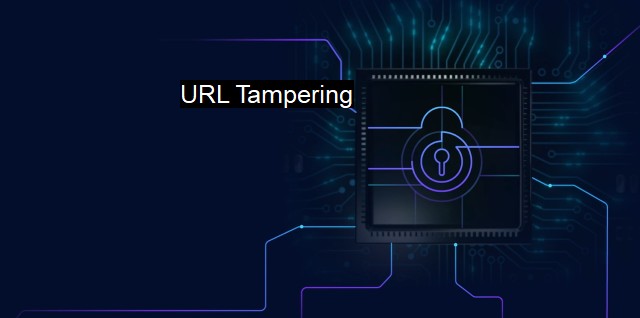What is URL Tampering?
The Threat of URL Tampering in Cybersecurity: Techniques, Impacts, and Antivirus Solutions for Protecting Sensitive Data from Hackers
URL tampering is a term frequently used and is something that anyone active on the internet needs to understand. URL tampering involves altering URLs in search of vulnerabilities and exploiting them. It's a malicious approach cybercriminals employ to manipulate or deceive web applications.URL tampering isn't about modifying any portion of a URL randomly. Instead, attackers alter parameters affectionately or conceal them to make behind-the-scenes modifications. Attackers discern these target locations within a URL by perusing HTTP responses. They specifically investigate areas where user input interprets into application behavior, browsing through the response and search for error messages, tracking redirections, repetitions, or any predictable sequences of session tokens.
The web application communicates these manipulated URLs back to the user's browser. If not guarded adequately against such manipulations, it could possibly expose a host of vulnerabilities or sensitive information, putting the application at risk of exploitation by hackers, breaches of sensitive data, or get redirected to insecure websites. Examples of URL tampering include unauthorized attempts to bypass access control, modify content or function of an application, tampering query strings, unauthorized data modification, and attempts at privilege escalations.
The motivation behind URL tampering usually revolves around exploiting web applications for data theft, fraud, vandalism, distribution of malware, phishing investor information, hijacking sessions, forging identification cookies, to name a few. They trick users into exposing confidential login credentials, payment details, or downloading malicious applications dressed benignly. Hence cybersecurity measures ought to be good enough to prevent or at least detect URL tampering.
A robust cybersecurity and antivirus system will help arm systems against URL Tampering threats. An active firewall, intrusion detection system, and an efficient antivirus software that can sniff out the malicious tempering codes can serve as effective defense mechanisms. An up-to-date browser is also crucial as updates often include patches to potential security vulnerabilities.
Adopting best security practices for URL parameters and related vulnerability points can safeguard organizations against URL tampering exploits. Regular monitoring of log-ins, closely observing third-party plug-ins, use of unambiguous form validation when building applications, using secure cookies, token systems, setting time-outs wherever possible along with best cyber-hygiene manners like access control and encrypted communications helps in navigating the expansive cloud spaces safely.
URL parameters should be validated, strongly typed, correctly attributed, verified for size and format in alignment with the robust application of wildlists or denylists. SSL/TLS encryptions should be availed to secure data transmission, alongside input validation, entire transaction procedures should also call for output validation or contextually appropriate data encoding.
Tampering detection mechanisms can be put in place and cleverly distributed control fields and cross-referenced data fields used. Employing HTTP response headers which feature Content-Security-Policy (CSP) is a good tactic to guard against cross-site scripting attacks.
In summary,Susceptibility to URL tampering can be detrimental not only for organizations but also for individuals users. URL Tampering is a reality in the cybersecurity landscape. Preventive and defensive measures that integrate technology, security best practices, and awareness programs with the active involvement of network users can significantly reduce the scope of hacker exploits. Undeniably, URL tampering is a menace; but well-structured and seamlessly integrated defensive and preventive measures incorporated into the software development a life cycle, network management strategy, users awareness programs and best practice application, coupled with efficient antivirus systems, can secure systems hugely against this cybersecurity threat. Protection can seem complex, yet technically and systematically it can certainly be a reality.

URL Tampering FAQs
What is URL tampering?
URL tampering is a type of cyber attack where a hacker tries to modify the URL of a website to gain unauthorized access to sensitive data or to trick the user into visiting a phishing website.How does URL tampering work?
URL tampering usually involves changing the parameters of the URL in order to manipulate the behavior of the website. The attacker can change the values of the parameters to gain access to restricted areas of the website or to inject malicious scripts that can steal sensitive data.What are the consequences of URL tampering?
URL tampering can lead to serious consequences such as data theft, loss of sensitive information, and identity theft. It can also lead to the installation of malware on the victim's computer, which can compromise the security of the entire network.How can I protect myself from URL tampering?
To protect yourself from URL tampering, it is important to always check the URL of the website you are visiting and make sure it is spelled correctly. You should also avoid clicking on suspicious links or downloading files from unknown sources. Using anti-virus software and keeping it updated can also help protect your computer from malware and other cyber threats.| | A | | | B | | | C | | | D | | | E | | | F | | | G | | | H | | | I | | | J | | | K | | | L | | | M | |
| | N | | | O | | | P | | | Q | | | R | | | S | | | T | | | U | | | V | | | W | | | X | | | Y | | | Z | |
| | 1 | | | 2 | | | 3 | | | 4 | | | 7 | | | 8 | | |||||||